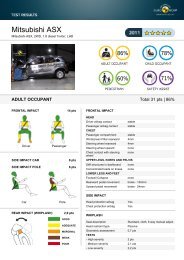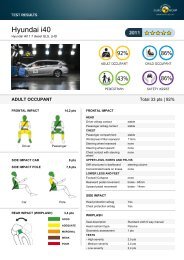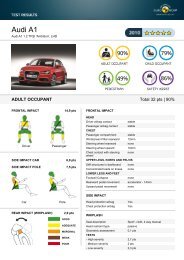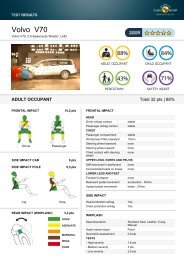Pedestrian Test Protocol - Euro NCAP
Pedestrian Test Protocol - Euro NCAP
Pedestrian Test Protocol - Euro NCAP
Create successful ePaper yourself
Turn your PDF publications into a flip-book with our unique Google optimized e-Paper software.
Energy (J)<br />
1800<br />
1600<br />
1400<br />
1200<br />
1000<br />
800<br />
600<br />
400<br />
200<br />
0<br />
Figure 28: Kinetic energy of upper legform to Bonnet Leading Edge tests with respect to<br />
vehicle shape<br />
Key: A = 50mm bumper lead<br />
B = 100mm bumper lead<br />
C = 150mm bumper lead<br />
D = 250mm bumper lead<br />
E = 350mm bumper lead<br />
Notes: 1. Interpolate vertically between curves.<br />
2. With bumper leads below 50mm - test as for 50mm.<br />
3. With bumper leads above 350mm - test as for 350mm.<br />
4. With bonnet leading edge heights above 1050 mm - test as for 1050mm.<br />
5. With a required kinetic energy above 700J - test at 700J.<br />
6. With a required kinetic energy below 200J - no test is required.<br />
11.5.4 The total mass of the upper legform impactor includes those propulsion and guidance<br />
components which are effectively part of the impactor during the impact, including the<br />
extra weights. Calculate the value of the upper legform impactor mass from:<br />
Version 7.0<br />
March 2013<br />
550 600 650 700 750 800 850 900 950 1000 1050<br />
Bonnet leading edge height (mm)<br />
2E<br />
=<br />
V<br />
M 2<br />
A<br />
B<br />
C<br />
D<br />
E<br />
Upper<br />
energy<br />
limit<br />
Lower<br />
energy<br />
limit<br />
46
















